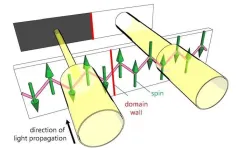(Press-News.org) Astronomers have used the NASA/ESA James Webb Space Telescope (JWST) to observe the ‘inside-out’ growth of a galaxy in the early universe, only 700 million years after the Big Bang.
This galaxy is one hundred times smaller than the Milky Way, but is surprisingly mature for so early in the universe. Like a large city, this galaxy has a dense collection of stars at its core but becomes less dense in the galactic ‘suburbs’. And like a large city, this galaxy is starting to sprawl, with star formation accelerating in the outskirts.
This is the earliest-ever detection of inside-out galactic growth. Until Webb, it had not been possible to study galaxy growth so early in the universe’s history. Although the images obtained with Webb represent a snapshot in time, the researchers, led by the University of Cambridge, say that studying similar galaxies could help us understand how they transform from clouds of gas into the complex structures we observe today. The results are reported in the journal Nature Astronomy.
“The question of how galaxies evolve over cosmic time is an important one in astrophysics,” said co-lead author Dr Sandro Tacchella from Cambridge’s Cavendish Laboratory. “We’ve had lots of excellent data for the last ten million years and for galaxies in our corner of the universe, but now with Webb, we can get observational data from billions of years back in time, probing the first billion years of cosmic history, which opens up all kinds of new questions.”
The galaxies we observe today grow via two main mechanisms: either they pull in, or accrete, gas to form new stars, or they grow by merging with smaller galaxies. Whether different mechanisms were at work in the early universe is an open question which astronomers are hoping to address with Webb.
“You expect galaxies to start small as gas clouds collapse under their own gravity, forming very dense cores of stars and possibly black holes,” said Tacchella. “As the galaxy grows and star formation increases, it’s sort of like a spinning figure skater: as the skater pulls in their arms, they gather momentum, and they spin faster and faster. Galaxies are somewhat similar, with gas accreting later from larger and larger distances spinning the galaxy up, which is why they often form spiral or disc shapes.”
This galaxy, observed as part of the JADES (JWST Advanced Extragalactic Survey) collaboration, is actively forming stars in the early universe. It has a highly dense core, which despite its relatively young age, is of a similar density to present-day massive elliptical galaxies, which have 1000 times more stars. Most of the star formation is happening further away from the core, with a star-forming ‘clump’ even further out.
The star formation activity is strongly rising toward the outskirts, as the star formation spreads out and the galaxy grows in size. This type of growth had been predicted with theoretical models, but with Webb, it is now possible to observe it.
“One of the many reasons that Webb is so transformational to us as astronomers is that we’re now able to observe what had previously been predicted through modelling,” said co-author William Baker, a PhD student at the Cavendish. “It’s like being able to check your homework.”
Using Webb, the researchers extracted information from the light emitted by the galaxy at different wavelengths, which they then used to estimate the number of younger stars versus older stars, which is converted into an estimate of the stellar mass and star formation rate.
Because the galaxy is so compact, the individual images of the galaxy were ‘forward modelled’ to take into account instrumental effects. By using stellar population modelling that includes prescriptions for gas emission and dust absorption, the researchers found older stars in the core, while the surrounding disc component is undergoing very active star formation. This galaxy doubles its stellar mass in the outskirts roughly every 10 million years, which is very rapid: the Milky Way galaxy doubles its mass only every 10 billion years.
The density of the galactic core, as well as the high star formation rate, suggest that this young galaxy is rich with the gas it needs to form new stars, which may reflect different conditions in the early universe.
“Of course, this is only one galaxy, so we need to know what other galaxies at the time were doing,” said Tacchella. “Were all galaxies like this one? We’re now analysing similar data from other galaxies. By looking at different galaxies across cosmic time, we may be able to reconstruct the growth cycle and demonstrate how galaxies grow to their eventual size today.”
END
‘Inside-out’ galaxy growth observed in the early universe
2024-10-11
ELSE PRESS RELEASES FROM THIS DATE:
Protein blocking bone development could hold clues for future osteoporosis treatment
2024-10-11
Scientists have identified a protein that blocks the activity of bone-forming cells (osteoblasts) by stopping them from maturing during the journey to sites of bone formation, a new study has found.
In a paper published in Communications Biology today (Friday 11 October 2024), a team of researchers led by Dr Amy Naylor and Professor Roy Bicknell along with their team including Dr Georgiana Neag from the University of Birmingham have found that protein CLEC14A, which is found on blood vessel cells called endothelial ...
A new method makes high-resolution imaging more accessible
2024-10-11
A classical way to image nanoscale structures in cells is with high-powered, expensive super-resolution microscopes. As an alternative, MIT researchers have developed a way to expand tissue before imaging it — a technique that allows them to achieve nanoscale resolution with a conventional light microscope.
In the newest version of this technique, the researchers have made it possible to expand tissue 20-fold in a single step. This simple, inexpensive method could pave the way for nearly any biology lab to perform nanoscale imaging.
“This democratizes imaging,” says Laura Kiessling, the Novartis Professor ...
Tiny magnetic discs offer remote brain stimulation without transgenes
2024-10-11
Novel magnetic nanodiscs could provide a much less invasive way of stimulating parts of the brain, paving the way for stimulation therapies without implants or genetic modification, MIT researchers report.
The scientists envision that the tiny discs, which are about 250 nanometers across (about 1/500 the width of a human hair), would be injected directly into the desired location in the brain. From there, they could be activated at any time simply by applying a magnetic field outside the body. The new particles could quickly find applications in biomedical research, and eventually, after sufficient testing, ...
Illuminating quantum magnets: Light unveils magnetic domains
2024-10-11
When something draws us in like a magnet, we take a closer look. When magnets draw in physicists, they take a quantum look.
Scientists from Osaka Metropolitan University and the University of Tokyo have successfully used light to visualize tiny magnetic regions, known as magnetic domains, in a specialized quantum material. Moreover, they successfully manipulated these regions by the application of an electric field. Their findings offer new insights into the complex behavior of magnetic materials at the quantum level, paving the way for future technological advances.
Most of us are familiar with magnets that stick to metal surfaces. But what about those that do not? Among ...
Different types of teenage friendships critical to wellbeing as we age, scientists find
2024-10-11
Being a teenager is hard, confusing — and crucially important. Scientists studying teenage socializing have found that teenaged friendships could lay essential foundations for wellbeing in later life, and that not just the kinds of friendships teenagers experience but the timing of those friendships is critical.
“A teen’s perception of how broadly socially accepted they are by their peers in early adolescence is particularly influential in predicting adult wellbeing,” said Emily Shah of the University of Arkansas, first author of the article in Frontiers in Developmental Psychology. “Conversely, in late adolescence, the quality of their more ...
Hawaii distillery project wins funding from Scottish brewing and distilling award
2024-10-11
Hawaii could soon be welcoming a new distillery after a postgraduate student at Scotland’s Heriot-Watt University won a prestigious entrepreneurial award.
Canadian student Ethan Wang, 42, wants to open a new distillery on Hawaii’s scenic volcanic island of Maui and said he was in “total shock” after winning cash and support from an industry membership organisation to help make his idea happen.
The award, called the Worshipful Company of Distillers’ Entrepreneurship Award, is designed to help students apply their science in the real world and is run jointly by Heriot-Watt’s respected International Centre for Brewing and Distilling and The Worshipful Company ...
Trinity researchers find ‘natural killer’ cells that live in the lung are ready for a sugar rush
2024-10-11
Trinity researchers find ‘natural killer’ cells that live in the lung are ready for a sugar rush
Trinity College Dublin researchers, based at St James’s Hospital have provided important insights into the behaviour and metabolic function of a previously largely unknown, but crucial ‘natural killer’ (NK) immune cell resident in the lungs. Their findings, published today [Thursday, 10th October 2024] in the journal: Proceedings of the National Academy of Sciences (PNAS) provide ...
$7 Million from ARPA-H to tackle lung infections through innovative probiotic treatment
2024-10-11
University of California San Diego and University of California Berkeley researchers have been awarded up to $7 million from the Advanced Research Projects Agency for Health (ARPA-H) to conduct research under the PROTECT project — Pro/Prebiotic Regulation for Optimized Treatment and Eradication of Clinical Threats. The project targets pathogens such as Pseudomonas aeruginosa and potentially Staphylococcus aureus, which pose significant health risks for individuals with cystic fibrosis and those dependent on respirators. PROTECT co-principal investigators are ...
Breakdancers may risk ‘headspin hole’ caused by repetitive headspins, doctors warn
2024-10-10
Breakdancers may be at risk of developing a condition caused by repeatedly doing a cardinal move of their practice and performance—the headspin—warn doctors in the journal BMJ Case Reports.
Dubbed the ‘headspin hole,’ or ‘breakdance bulge,’ the condition is unique to breakdancers, and appears as a protruding lump on the scalp, often accompanied by hair loss and tenderness.
Breakdancers are particularly prone to injuries because of the complexities and physical demands of the moves, note the authors. Sprains, strains, and tendinitis are particularly common. Head and brain injuries, including subdural haematomas (pooling ...
Don’t rely on AI chatbots for accurate, safe drug information, patients warned
2024-10-10
Patients shouldn’t rely on AI powered search engines and chatbots to always give them accurate and safe information on drugs, conclude researchers in the journal BMJ Quality & Safety, after finding a considerable number of answers were wrong or potentially harmful.
What’s more, the complexity of the answers provided might make it difficult for patients to fully understand them without a degree level education, add the researchers.
In February 2023, search engines underwent a significant shift thanks to the introduction ...



